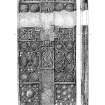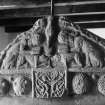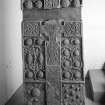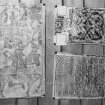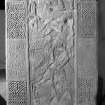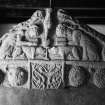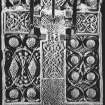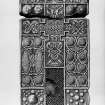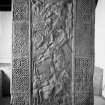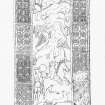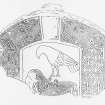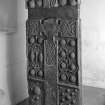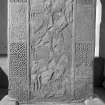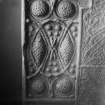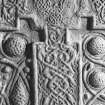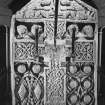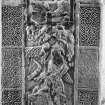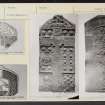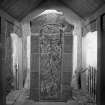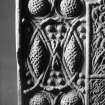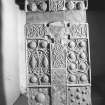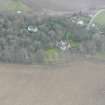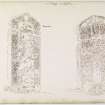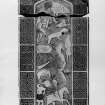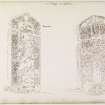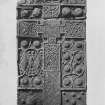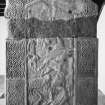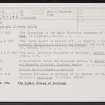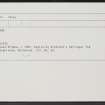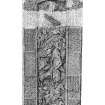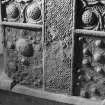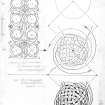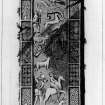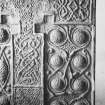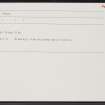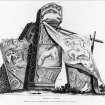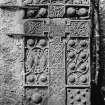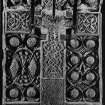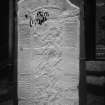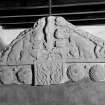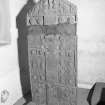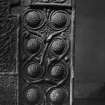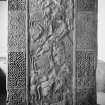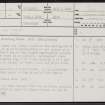Nigg
Cross Slab (Early Medieval), Pictish Symbol Stone (Pictish)
Site Name Nigg
Classification Cross Slab (Early Medieval), Pictish Symbol Stone (Pictish)
Alternative Name(s) Nigg Church; Nigg, Old Parish Church; Nigg Churchyard
Canmore ID 15280
Site Number NH87SW 1
NGR NH 8045 7171
Datum OSGB36 - NGR
Permalink http://canmore.org.uk/site/15280
- Council Highland
- Parish Nigg (Ross And Cromarty)
- Former Region Highland
- Former District Ross And Cromarty
- Former County Ross And Cromarty
Nigg, Ross and Cromarty, Pictish cross-slab fragments
Measurements: H 2.05m +, W 0,87m, D 0.16m
Stone type: grey sandstone
Place of discovery: NH c 8045 7169
Present location: in the south-west end of the church at Nigg.
Evidence for discovery: first recorded visually by Cordiner in the late 18th century, but known to have stood in the kirkyard until 1727, when it was blown down. Thereafter it stood close to the east gable of the church, until it was moved towards the end of the century and broken in the process. The lower portion was then re-erected upside down and remained in that position until Allen had it taken down at the end of the 19th century, and the two fragments were joined (too close together) with concrete and placed in a modern base in the kirkyard at the west end of the church. By 1972 a shelter had been built over it, and within the decade it had been taken into the church and erected at the south-west end. A fragment of the missing portion was found in the burn to the east of the church in 1998. The stone was conserved in the early 21st century and the new fragment placed in its proper position between the two larger fragments.
Present condition: parts of the upper portion and the base are missing and the slab is very weathered.
Description
Nigg represents ‘the supreme masterpiece of Pictish art’ (Henderson & Henderson 2004. 227).
The rectangular slab has a pedimented top and very slightly tapering sides. It is carved in relief on both broad faces and on one narrow face (the other narrow face may have been trimmed or have suffered obliteration from weathering). The panels on both broad faces and the cross on face A are bordered by roll mouldings.
Face A bears a slender cross with rectangular arms, square indents and a square centre, set on a long shaft. The side-arms extend to the sides of the slab and the upper arm to the lower frame of the pediment. The arms contain interlocking beasts with fine thread-like limbs, and the square centre is filled with nine circular knots in three rows of three knots. The lower shaft contains dense diagonal key-pattern. The panels on either side of the cross are carved with high-relief and intricately carved bosses, serpents and spirals. The top edge of the pediment is bordered by plaited palm trees, enclosing the bowed figures of St Paul and St Anthony but leaving a space at the apex for the raven to deliver the host to the readied chalice between the two saints. They hold books, almost resting on the backs of the two crouched animals guarding the chalice.
The carving on narrow face B is much damaged but there were certainly four panels or ornament.
Face C bears a long panel of figural carving within a wide border divided into panels crammed with patterns: diagonal key pattern, interlinked ring-knots and interwoven spirals. Beneath the eagle and Pictish beast symbols at the top, the central panel is devoted to David, although his figure, once carved in high relief, is severely defaced. He is shown rending the jaws of the lion, with his own symbols of lamb and harp in front of him, and images of the royal hunt above and below.
Date: ninth century.
References: Cordiner 1788; ECMS pt 3, 75-83; Henderson & Henderson 2004, 41, 48, 139-40, 129-31; Fraser 2008, no 124.
Desk-based information compiled by A Ritchie 2017
NH87SW 1 8046 7171 moved to 8049 7170
See also NH87SW 5 and NH87SW 10.
(NH 8046 7171) Standing Stone (NR) (Sculptured)
OS 6" map, Ross-shire, 2nd ed., (1907)
This sculptured stone has always stood in the churchyard at Nigg. Repaired at Allen's instigation it now stands on a modern base at the W end of the church immediately outside the vestry. The stone is an upright, rectangular cross slab with a pedimented top, 7ft 3ins high by 3ft 5ins wide, sculptured in relief on front, back and right side.
J R Allen and J Anderson 1903.
A sculptured cross slab as illustrated. It is preserved under an open-sided porch at the NE end of the church.
Visited by OS (A A) 25 September 1972.
(NH 8046 7171) Cross Slab (NR)
OS 25" map, (1974)
This cross slab has been removed from its previous position and is now preserved in Nigg Old Parish Church at the SW end. (NH 8049 7170)
Visited by OS (J B) 26 February 1981.
Class II symbol stone : on the face is a cross with a scene depicting SS.Anthony and Paul and the raven. On the reverse is an eagle above the remains of an elephant with a hunting scene showing a hound and a deer and one monted figure and one standing. Above are an illustration of David with the lion and sheep.
A.Mack 1997 p.117
A series of drawings of early medieval carved stones was created, forming a 'visual index' for deposition in the NMRS, with supporting material, of:
NH 804 717 Old Nigg Church (Nigg parish)
Sponsor: Society of Antiquaries of Scotland.
I G Scott 1997
NH 8047 7173 During a Moray Society field trip in August 1998, a piece of the missing section of the Nigg cross slab was found in the bed of a small burn a few metres below the E gable of the church. The fragment measures 42.5 x 16.5 x 6cm, and shows most of the body of the 'Pictish beast' symbol, decorated with key pattern. The relief carving is well-preserved, though stained by algae. The other (cross-bearing) face of the stone is broken off. The carved surface was lying uppermost and quite plain to see, which may imply that the fragment was formerly buried and had only been washed out of the bank of the stream recently. The stone is at present in the care of Nigg Old Trust.
Sponsors: Moray Society, Nigg Old Trust.
S Halliday 1998.
Field Visit (November 1978)
Nigg, Cross-slab and Church NH 804 717 NH87SW 1 & 5
This parish church, dedicated to St Fiacre, dates from 1626 but the earliest reference to a church on this site occurs in 1255-6. A fine Class II 'Pictish' cross-slab stands within the church.
RCAHMS 1979, visited November 1978
(OPS 1851-5, ii, 454; Cowan 1967, 157; Allen and Anderson 1903, iii, 75-83)
Publication Account (1995)
This great stone, which once stood outside the east end of the parish church, has been cleaned, repaired and re-erected inside a room at the west end of the church. The cross face of the stone has bossed ornament, as at Shandwick, but here the Pictish carvers have set the bosses on the background, not on the cross itself. At the top, in a triangular pediment, are two tobed human figures bowing down their heads; representing St Paul and St Anthony in the desert, as recounted in the Lives of the Saints. The bird between them with a round object in its beak is the raven which usually supplied St Paul with half a loaf, but cannily brought a whole loaf when St Anthony visited him. The two animals may be the lions which helped St Anthony bury St Paul.
The great cross is covered with key pattern and interlace, some of it formed by the threadlike bodies of pairs of animals. Part of the top is missing, and has been left blank in the restoration. Either side of the cross are elaborate bossed patterns in six panels, all different but balancing. In the central panels the bosses are covered with meshlike interlace and surrounded by the bodies of snakes. In the lower panels are swirling peltas.
The back of the stone is framed by a wide border, within which at the top is an eagle symbol. It is known from old drawings that a 'Pictish beast' symbol filled the space beneath. The rest of the back is badly damaged, but has traces of various figures and animals connected 'with Biblical accounts of David as shepherd, warrior, king and psalmist. At the top left is a man standing holding spear and shield, with two beasts in front of him;centre left, a sheep with a very curly coat and a harp below; to the right David rending the jaws of the lion (what looks like a wing is drapery); bottom left, a man holding two cymbals, following a man on horseback hunting a deer.
The white-harled Nigg church was built in 1626 probably on the site of an earlier church. It was originally rectangular, but has been altered several times and a north aisle added.
Information from ‘Exploring Scotland’s Heritage: The Highlands’, (1995).
Watching Brief (2013)
NH 8045 7171 A watching brief was carried out during removal of concrete from floor levels at Nigg Old Church as part of a project to re-house and re-display the Nigg cross slab. The stone has been housed in the W end of the church beneath the W Loft since March 1978, when the floor was lowered. The present work was undertaken as a precaution in case features, artefacts or human remains survived in situ.
After the removal of the stone for conservation, the existing concrete floor was removed. The floor overlay a uniform layer of loose, orange-brown sand and grit, which appeared to be the floor make-up within the church. It was cleaned off, but no features or artefacts were recorded. The layer was left in situ apart from a small area, c200 x 300mm, which was trowelled back. It was found to be c20mm thick and overlay virtually identical, but compacted sand and grit containing fragments of lime mortar.
The concrete walls and floor of the pit created in 1978 for the cross slab were not removed, apart from the lower of two concrete steps which provided access to it. The only feature recorded consisted of two well preserved sandstone slabs, partly visible in the doorway to the main body of the church, which will remain in situ. They had been dressed on the upper surface only and were clearly intended as paving.
Archive: HAS. Report: Highland HER
Report: Nigg Old Trust
Lynne McKeggie and John Wood, Highland Archaeology Services, 2013
(Source: DES)
































































